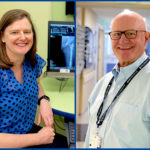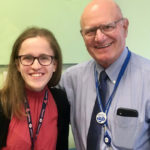Generations of excellence in lower extremity care: Dr. Kasser and Dr. May

As an orthopedic surgeon and professor of surgery, Dr. James Kasser has spent several decades sharing his expertise in limb reconstruction with students of Harvard Medical School. Dr. Collin May was one of his students and later joined the surgical team in the Lower Extremity Program at Boston Children’s Hospital. He has spent the past decade honing his skills and caring for patients — often with Dr. Kasser’s mentorship.
After 20 years as chair of the Orthopedic Center and another 10 as Boston Children’s surgeon-in-chief, Dr. Kasser stepped back from his administrative duties last summer. While he continues to care for patients, Dr. May and his colleagues in the Lower Extremity Program are taking the lead in caring for Dr. Kasser’s long-term patients.
Here, the two surgeons talk about how young physicians develop expertise and the unique culture that enables the orthopedic surgeons at Boston Children’s to treat highly complex cases.
Why did you decide to practice at Boston Children’s?
Dr. May: It started when I was a medical student, then resident, rotating through the Harvard hospitals. The culture at Boston Children’s was different than anything I experienced in any other hospital. I was really struck by the inclusion and support I experienced here.
This place breeds a way of looking at things: the children we’re treating come first.”
Dr. Collin May
I originally thought I would go into adult trauma. This started to change as I worked with the lower extremity team and Dr. Kasser. I vividly recall casting children with clubfeet and the meticulous care Dr. Kasser took with these patients. Then, while researching and giving a talk on cavovarus foot differences, something clicked and I knew I wanted to devote my career to working on foot conditions and limb differences.
How do you select surgeons to practice in the Orthopedics Center?
Dr. Kasser: Teaching medical students gives us the opportunity to find those who have a real interest in pediatric orthopedics. Sometimes you actually see that light go on as a student decides this is the path they want to pursue.
We can also see who is going to thrive in the collaborative culture here. If you have a big ego, if you think you have to solve every problem on your own, you won’t fit in at Boston Children’s. People who want to work in this environment really embrace the way we work together.
How does educating medical students affect patient care?
Dr. Kasser: Patients benefit from being treated by a physician who is also educating students. When someone’s questioning what you’re doing and why you’re doing it, it pushes you to make sure you’re doing the right thing. You’re discussing alternatives and improving care in the midst of taking care of that patient.
How do you approach complex cases with no clear solution?
Dr. May: The collaborative culture at Boston Children’s is one of the reasons we can take on complex cases. When I’m treating a case with no clear solutions, I often turn to Dr. Kasser and my other surgical colleagues to talk through possible approaches. This place breeds a way of looking at things: the children we’re treating come first. Our focus on patients drives us to find the best possible solutions to difficult problems.
If you have a big ego, if you think you have to solve every problem on your own, you won’t fit in at Boston Children’s.”
Dr. James Kasser
Boston Children’s is known for its innovative care. Do you ever find the latest and greatest procedure isn’t the best option for a patient?
Dr. Kasser: Orthopedics has evolved over the years and new, interesting procedures have emerged. Some of them have been developed here. The question is, what’s best for your patient? Often, they’re better off not having surgery. Or maybe the best approach for a given patient is very different from the latest procedure everyone is talking about.
We have these conversations with patients and families all the time. It’s important for us to understand what matters most to them and for them to know what to expect from various treatment options.
How has your working relationship evolved?
Dr. May: You enter into this job as a young physician, and there are giants in the field like Dr. Kasser. I think you go from looking up to them initially to working closely as colleagues. Having benefited immensely from the influence of Dr. Kasser and others who trained me, I have a sense of duty to pay that forward to the younger physicians I’m training. I also feel a great sense of pride and responsibility in taking over many of the patients Dr. Kasser has cared for over the years.
What do you consider to be your legacy at Boston Children’s?
Dr. Kasser: When I took over as chair of orthopedics in the mid-90s, I pushed people to develop a specific area of expertise. Everyone in the department still treats general issues like fractures and trauma. But every orthopedic physician at Boston Children’s now has a specialty they’re recognized for. When a patient comes to us for care, whether they have an issue with their spine, hip, or another area, they are treated by someone who specializes in the specific type of care they need.
What do you look forward to in the coming year?
Dr. May: Because of the pandemic, a lot of our patients have not been to a doctor for a year or more. We’re seeing a lot of lower extremity issues that didn’t get taken care of early and need more intensive treatment now. I’m looking forward to the challenges that will come with treating these patients.
Dr. Kasser: Collin and I were talking the other day about how we need to find more young surgeons to join the team. He, Dr. Samantha Spencer, Dr. Susan Mahan, and Dr. Carley Vuillermin are now in the position of mentoring another generation of orthopedic surgeons at Boston Children’s. I look forward to playing a role in making sure the ethic of collaboration that makes this department great remains central to how we care for patients.
Learn more about the Orthopedic Center and Lower Extremity Program.
Related Posts :
-

Limb-lengthening surgery: A look at the pros and cons
Limb length discrepancies, a leg or arm that’s shorter than the other, can occur for a number of reasons. ...
-

Clubfoot bracing for an active boy: Finn’s story
When Finn Beaulieu learned how to say elephant, he ran around the house repeating the word at least 20 times. When ...
-

Leg lengthening and hip surgeries inspire a career
Lauren Schoeller was in eighth grade when she decided to become an orthopedic surgeon. She had by then had multiple ...
-

New hope for Caden's leg after accident
By the time he was 12, Caden had spent almost half his life struggling to keep up with his peers. When ...





